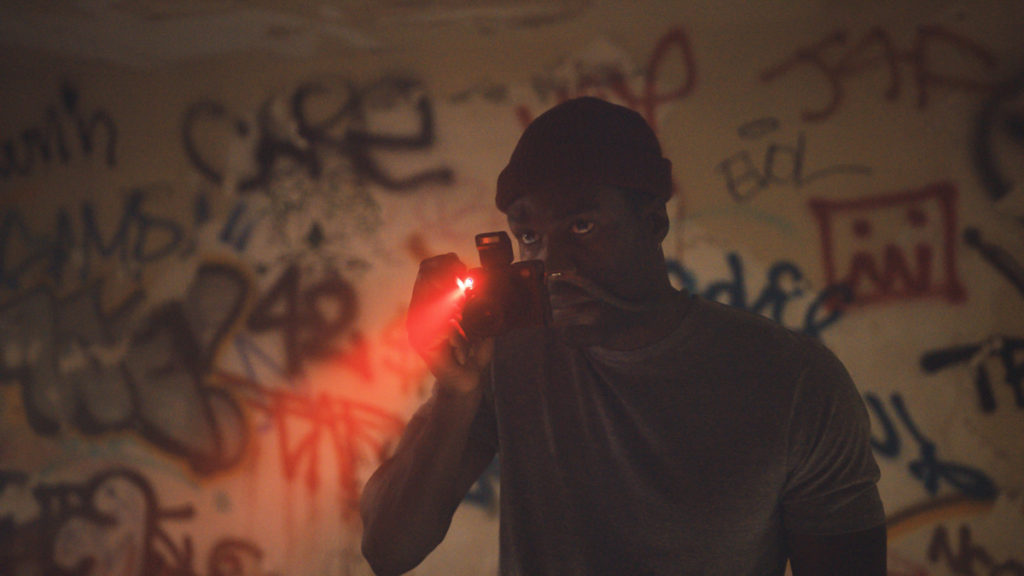
Candyman
Nia DaCosta’s Candyman begins and ends so well and is loaded with enough potent ideas that it’s easy to mistake for a good movie. It’s actually a botch in ways that should feel familiar – from the original movie or from producer/co-screenwriter Jordan Peele’s Us.
I absolutely don’t want to diminish the substantial accomplishments of these three works, because they mostly fulfill their lofty goals in a genre not known for its ambitions.
But I hate that the new Candyman mostly repeats the same core mistake as Us. Each has a horror premise that gives strong yet graceful voice to its pointed, incisive politics (class-based in Us, race-based in Candyman). But the impact is dulled by overloading the story.
And while DaCosta’s movie is more skillful and polished than Bernard Rose’s 1992 Candyman, its primary misstep is similar but larger. The actual existence of Candyman outside of the protagonist made the original much less interesting, but you could almost squint it away; this reboot makes it impossible to ignore.
As rich and resonant as the new movie is, it feels padded even at 91 minutes. And some confounding last-act plot particulars are bizarrely complicated and seem to come out of nowhere; this is especially strange given that its destination should have naturally led to an elegantly simple story. (I’m guessing that early versions of the script – credited to Peele with Win Resnfeld and DaCosta – proved problematically short.)
Shot choices in the climax add to the late problems, particularly with the political content/context of the movie. Bringing the backstory – an innocent black man killed by the white establishment – into the present pays enormous dividends throughout. Yet DaCosta’s camera refuses to show the movie’s single most-important moment, letting its audience off the hook when it comes to the real horror.
Generally, though, it’s easy to appreciate the many ways Candyman towers over most of its peers: a credibly human central performance by Yahya Abdul-Mateen II despite being given little more than a type; the clever and beautifully executed handling of backstory; gorgeously thoughtful cinematography and direction; and evocative production design expert at everything from dilapidation to modern art, with mirrored surfaces everywhere daring you to look into them.
Yet the movie is so great at its terminals that its failings finally make it a serious disappointment.
The last five minutes are fantastic, a nearly perfect encapsulation of everything Candyman is trying to say, horrific yet also cathartic.
And the immaculate precision of the first 20 minutes paves the way for those conflicting feelings.
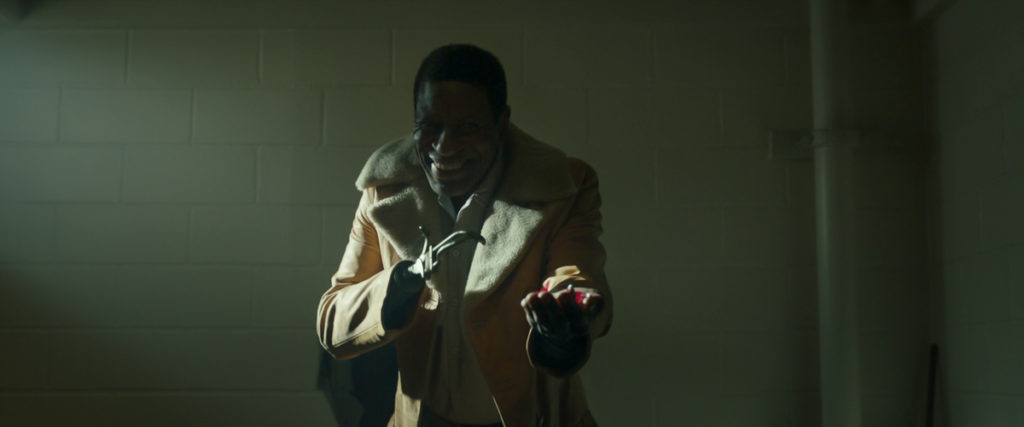
Carefully Calibrated Unease
A boy is going to wash clothes in a Cabrini-Green basement in 1977. As he approaches the glass door to the laundry room, the timed light inside goes out, revealing a reflection of a hole in the wall behind him. The next shot watches the boy turn around through the hole in the wall. Then, from the boy’s perspective, it’s now a trompe l’œil painting of a hole in the wall.
This is not the movie mimicking the boy’s experience, with his imagination and fear turning a benign illusion into something scarier. The camera was positioned behind the wall before we’ve even seen the hole as a painting, giving that earlier reality greater weight.
I began to doubt what I knew I’d seen. Was it even meant to look like a painting?
It’s not long, of course, before Candyman comes through that hole. He has all the basic trappings of Rose’s 1992 version of the character – tall, dark skin, hook in place of a hand, long coat – but he’s different in a way that’s unexpectedly creepy, a sort of uncanny-valley effect. It’s obviously Candyman, and it clearly ain’t.
The opening’s carefully calibrated unease is sandwiched between two inessential bits that set up and then reinforce the audience’s reaction.
The first is the collection of production-credit animations, which is reversed as if seen in a mirror – a foreshadowing flourish carrying an implicit promise: Everything is meaningful. The musical choice is supremely on-the-nose yet so wrong for the material that it’s immediately right.
And after the opening scene, the camera tilts up into the opening credits, over a presentation of Chicago that’s cold, dreamy, and strangely disorienting and anxiety-inducing because of the perspective and camera movement. Robert Aiki Aubrey Lowe’s music lives in the same neighborhood as Philip Glass’ delicate minimalist score for Rose’s movie but is a muscular, searching contrast.
Everything about the movie to this point is familiar but also off enough that it’s exciting. You want to see where Peele and DaCosta are going to take you, how they’re going to bend Rose’s vision to their own interests.
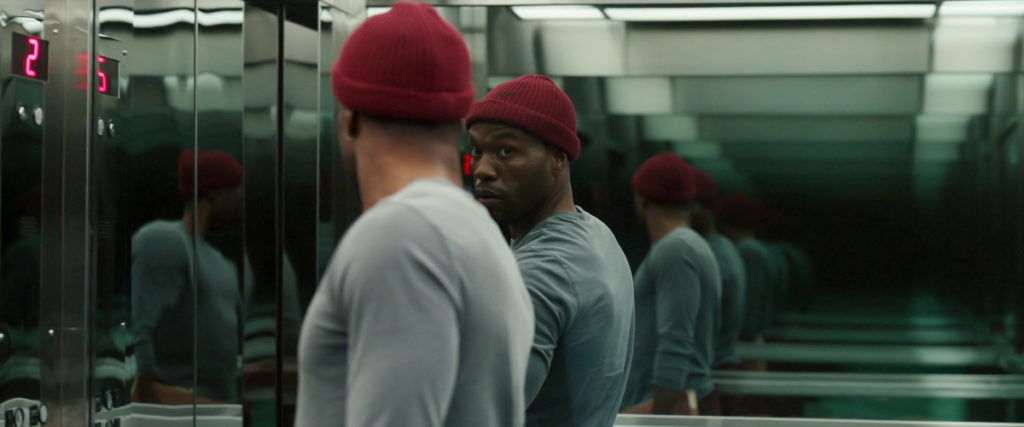
First a Victim
The story proper concerns artist Anthony (Abdul-Mateen), who one night hears the story of Helen Lyle – whose name should sound familiar. His curiosity is piqued, and he’s desperate for a subject to paint, so he goes out to the remains of Cabrini-Green to take some pictures.
He meets a guy named William (Colman Domingo) who tells him a different story: about Candyman. “For me,” he starts, “Candyman was a guy named Sherman Fields.”
And we’re back to 1977. William refers to Sherman as a “neighborhood character. Used to stand out there and hand out sweets to us when I was a kid.” He’s shown first in a wide shot, dwarfed by the public-housing building behind him.
When we again see him outside of the laundry room, we finally get a good look at his face, and he’s immediately more pathetic than menacing. That smile is disconcerting, but it might just be his version of friendly. Does he intend harm, luring children with sweets, or is he just … simple? Nearly everything is ambiguous, and the result is the discomfort of ambivalence.
Ultimately, Sherman was killed by police who wrongly assumed he was putting razor blades in candy, and it’s here that Peele’s and DaCosta’s reversal of emphasis becomes clear. Candyman is still a hook-wielding killer in the new movie, but he is first and foremost a victim.
Fundamentally, the 2021 Candyman is connecting two very large dots from Rose’s movie – a black man murdered long ago by a white mob and the poverty of Cabrini-Green – and continuing the line to the present. The forced isolation of communities of color, the eventual gentrification of those neighborhoods, and police violence against blacks are all explicit parts of the picture of systemic racism here.
The singular Candyman of Rose’s movie becomes a hive of them, murdered black men transformed into urban legends. Except instead of being stories about monsters summoned, they’re more cautionary tales about how the monsters were created; they’re warnings to black kids about the dangers of white people in authority.
The layers keep building. You conjure Candyman by saying his name five times in a mirror; you memorialize victims of police brutality by saying their names. One’s done on a dare and one’s a political act. In Candyman, they’re the same.
The idea of remembrance through storytelling is reinforced through the movie’s regular and effective use of shadow puppetry, employed from its very first shot through the closing credits. This is a nod to the fact that Candyman melds two well-known stories from the oral tradition: Bloody Mary and The Hook. More importantly, it underscores the reasons these stories take hold: They’re oblique expressions of what scares us or what should scare us.
In this movie, the meaning is different depending on the audience. For white people, Candyman represents fear of the black man; for blacks, the story is about what happens when one runs afoul of whites with power.
It works, and you don’t have to be a genius to figure out what fate awaits Anthony as he becomes obsessed with the Candyman stories. When his girlfriend gets frightened by his increasingly erratic behavior, you dread where it’s headed.
It’s largely forgivable that DaCosta overplays the inevitability with a bee sting on the hand. But a handful of other narrative choices are tougher to overlook.
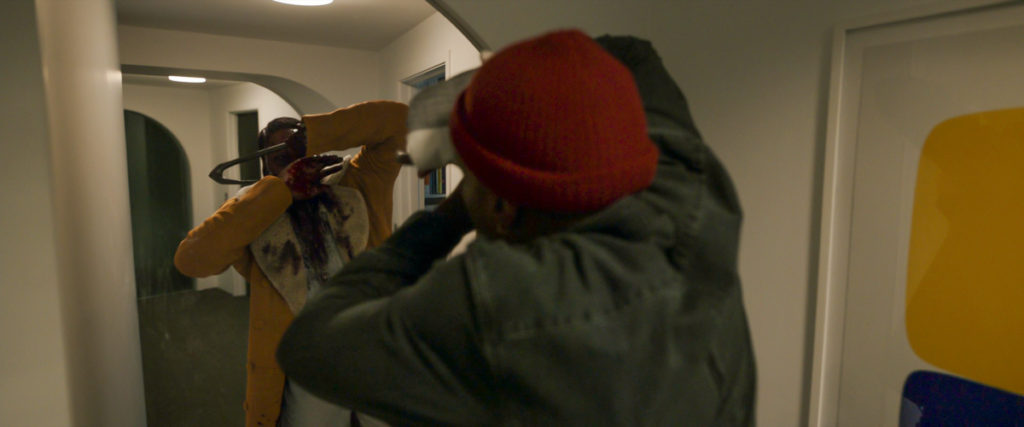
Candyman Doing What Candyman Does
As you’ve probably guessed, Candyman is real in Candyman, and he brings oh so many problems with him.
This is the part of the essay where I remind you of the Spoiler’s Creed. And also where you decide I’m a moron, because the least-successful parts of the movie to me involve Candyman doing what Candyman does.
DaCosta has two showcase kill collections: an art dealer and his girlfriend in a gallery, and some prep-school girls in a bathroom. (There’s also an art critic, shown from a distance.)
I get why they’re there. Why would somebody make a slasher movie without lots of slashing? And DaCosta clearly relishes the challenge of abiding by certain rules with Candyman, making the murders look credible with an invisible attacker while using as many reflective surfaces as possible to show another reality.
These scenes try a bit too hard, but that misses the point: They shouldn’t exist, because there’s really no reason for a physical Candyman to appear in the movie’s present before the climax.
Yeah, I know: The victims all did that stupid thing they weren’t supposed to do, so what should I expect? And I guess it counts as progressive that all of the victims are white. (I’d say one of the prep-school victims might be mixed-race, but the movie makes a point of having a girl of Asian descent bailing on the recitation, and a black girl in one of the bathroom stalls escaping with her life. So probably not.)
Plus, the movie by this point has clearly suggested a psychic link between Candyman and the artist after that sting – even though there’s no way Anthony could be physically responsible for the deaths.
In the first appearance of a murderous Candyman, the movie cross-cuts between the gallery and Anthony at home, where he becomes fixated on a bee. When he watches a news report about the double murder the next day, he’s not at all shocked or horrified. He smiles, because the newscaster mentioned him and his new piece. “Say My Name. They said my name.”
And Anthony is in the art critic’s apartment right before she’s murdered, one of several times he sees Candyman in a mirror in place of himself. (As a black man who’s let the stories get under his skin, he’s terrified he might be the next version of that tale.)
In addition, he has grievances against both the art dealer and the critic.
As for the high-school girls, I got nothin’. One of them was at the art reception, but their only sin is being rich, white, and stupid enough to say something five times in front of a mirror.
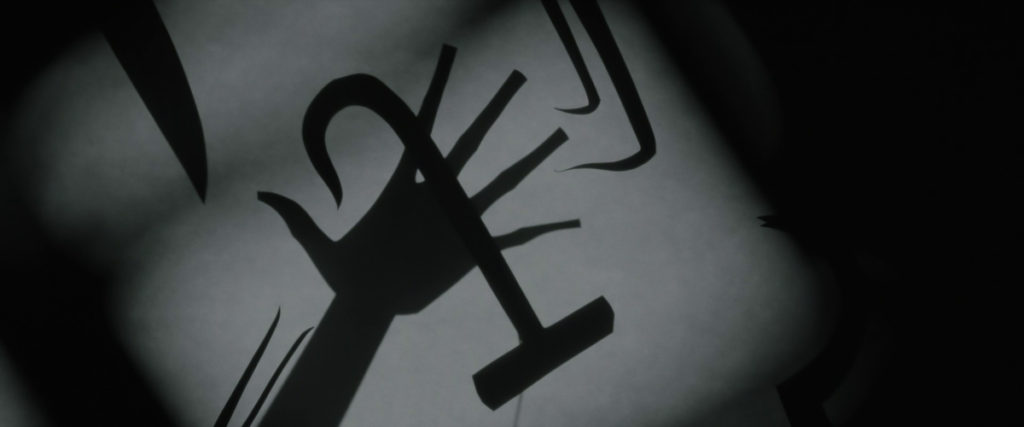
Half-Baked Ideas
And then there’s the weird stuff that suggests writers struggling to turn a strong central idea into a feature-length movie. Or maybe studio editors struggling to cut an overly ambitious movie into standard horror-movie length. I dunno, but a number of bits feel half-developed or -articulated, to varying degrees of success.
I kinda liked the elliptical hints about Anthony’s girlfriend’s father (an artist, not coincidentally).
And I didn’t initially mind the direct linking of this movie to Rose’s original. (How old is Abdul-Mateen?)
Anthony getting stung by a bee was a bit much, but then that wound starts to look really bad, and for far longer than makes sense he just scratches and picks at it instead of going to a doctor or the ER. (Perhaps it’s a clumsy attempt to illustrate the distrust people of color have with American medicine?)
I was certain the hand was going to get so itchy that Anthony was going to chop it off himself, but I was wrong. (Again: the Spoiler’s Creed.)
Enter William, whose sole function seemed to be He Who Provides Context and He Who Articulates Themes … .
I wish I knew the thought process here, because William shifts from a purely functional background character to Candyman’s Renfield without warning or obvious motivation. We get a flashback to his sister and her friends being murdered after saying that name five times, but I can’t figure out why he’s so hell-bent on molding Anthony into a new Candyman. (I do, however, love that the guy traumatized as a kid by Candyman near the laundry room now runs a laundromat.)
But there it is, and we get to that moment when Anthony, drugged by William and harmless, is shot down by a police officer.
“Shot down” is imprecise. He’s basically unconscious, lying in his girlfriend’s lap, and we’re asked to accept that the officer would enter the room and shoot him immediately. Because DaCosta chooses not to explicitly show the action, we can’t see the officer’s expression. And we can’t see if there’s something about Anthony that could be construed as threatening – or if, as is almost certain, he is clearly a threat to nobody.
Instead, the officer is shown as a shadow (admittedly, a sly repetition of a motif), and the camera then focuses on the girlfriend.
I’m white, and that absolutely colors my reaction to this moment, but I don’t buy it. It would have been easy – and far more effective – to have Anthony upright but addled, to even have him asking for help. (At this point, he’s been sedated and had a hook shoved into the wound where his hand was.)
But if the intent is to hammer home what has too often happened to black men at the hands of police, DaCosta does a disservice by essentially looking away.
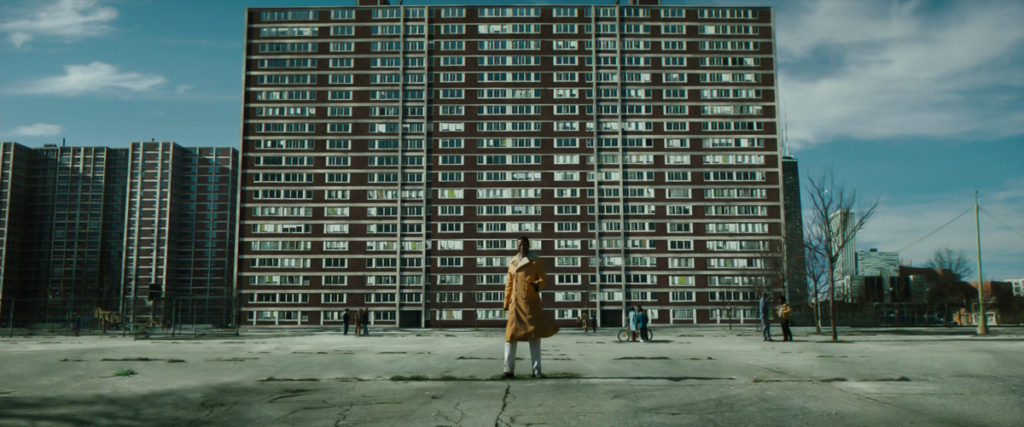
Its Purest Self
Having dealt with the text, I ask your indulgence to consider what might have been.
What if we chucked all the late William stuff and built the climax around an encounter between Anthony and his girlfriend – with her mix of love, concern, confusion, and fear providing the tension before the police arrive?
What if we dispensed with the three scenes of white people murdered by Candyman prior to the ending?
What if, in other words, we limited the killing to tales told and stories shown in shadows until the final 10 minutes, when an urban legend could become real with serious impact? When we could finally see the real crime in the present, and the bloody vengeance?
I have no doubt that somebody can construct or has constructed a coherent explication of the movie as it stands – articulating a narrative function for those three mid-movie kill scenes and explaining William’s plan, his certainty of the return of a certain child, and his belief in Candyman as a social good for the neighborhood.
But the cleaner, clearer, more-powerful version of the movie is right there. The only real problem with Candyman is that it confuses and muddies its message by refusing to become its most-efficient and -effective self: the all-too-familiar story of a black man who goes just a little wrong and gets killed by police for it. And then the shockingly right story of a pissed-off Candyman who does something about it, in the process becoming a legend.
Yes, the optimal form of what’s presented here might only be 75 or 80 minutes. But they would have been 75 or 80 minutes that would have been talked about for years.

